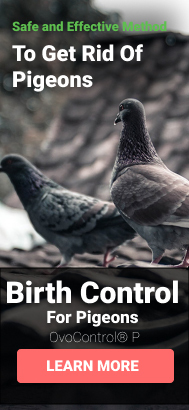Learn how we help food processing facilities solve their pigeon problems.
Consistent with rodent and insect mitigation, bird control at food processing plants and facilities is a critical element for maintaining a clean and contamination free environment.
USING OvoControl® at food processing facilities
Food processing facility managers are typically aware of the problems pest birds can cause. Many species of birds, including pigeons, starlings and sparrows, often gather to roost on a plant’s roof, under parking structures, in receiving bays and loading docks and especially where food or waste is available. Without effective bird control a serious food safety hazard and regulatory compliance issue can quickly develop.
A flock of just 100 pigeons excretes approximately 4,800 pounds of waste annually. The bacteria, viruses, funguses and ectoparasites contained in bird droppings and nesting materials represent the starting point for contamination and over 60 different transmissible diseases, including histoplasmosis, encephalitis, salmonella, meningitis, and toxoplasmosis and even the West Nile virus.
No less dangerous is the fecal dust drawn into the plant through rooftop heating, ventilation and air-conditioning ducts. Birds often build nests around air handling equipment, ducts, compressors and other vented pathways. Dried by wind and the sun, this contaminated dust gets drawn into HVAC systems. The fine particles can quickly spread pathogens throughout a plant.
Facility managers should also be aware of the visual impact bird droppings, nests and other debris can have on a plant’s image and attitude of employees at the plant. Evidence of birds sets a poor example for reducing the risks of contamination in the products produced at the plan
New FDA Rules, Requirements, and Authority for Food Safety
The Food Safety Modernization Act (FSMA) signed into law in January 2011 gives the U.S. Food and Drug Administration (FDA) wide ranging new powers and responsibilities in food processing and inspection. Food processing firms are subject to increased regulatory scrutiny and action. FDA is empowered with recall authority based on a relatively modest hurdle – a “reason to believe”– rather than the identification or discovery of actual contamination.
Additionally, the FDA, as mandated by FSMA, has launched a new searchable recall database to provide transparency to consumers for food safety issues – https://www.fda.gov/food/guidance-regulation-food-and-dietary-supplements/food-safety-modernization-act-fsma. This database provides even greater pressure on industry to ensure the safety of their products as the potential for widespread brand damage increases.
Pest birds living in or on a food plant are as much of a concern as rodent or insect infestations. FDA does not require evidence of direct contamination for a plant to be cited. Simply the evidence of pests, even without contamination may constitute a potential hazard and could result in an FDA citation. Food inspectors are often on the lookout for feathers, nesting material or fecal matter.
Bird Control Alternatives and Programs
Food processing facilities and plants are somewhat limited in their choice of pest bird control alternatives. Noisemaking devices including firearms, cannons or fireworks are typically out of the question. Poisons present too much of a liability and are no longer readily available even through pest controllers. Fortunately, safe and cost-effective bird control solutions are readily available for pigeon control at food processing facilities.
Exclusion
Food processing facilities are typically large in scope and footprint. For this reason, exclusion techniques and devices should be considered for at least part of the bird control solution. Options include spikes, netting, electric shock track and bird slope for landing areas.
All exclusion devices are designed to keep birds off of selected surfaces, perching points, ledges or confined areas. Unfortunately, in the very best case, the birds will leave the treated areas and find others in the same general vicinity. That said, these devices are invaluable for removing high value or sensitive areas as landing points for the birds. That said, bird proofing every possible surface and area at a large facility is typically not an option.
Removal
Removal options in a food processing environment are typically limited to live trapping. Birds cannot be relocated since they will simply return to the same flock and site and must be euthanized. Adequate food and water must be placed inside the trap. This alternative is typically labor intensive since traps must be checked daily in most states. Furthermore, similar to shooting or poisoning, the birds go into reproductive overdrive once the flock begins to thin out.
Contraception
Although exclusion and removal tools have their place, pigeons are very adaptable and require an integrated program of pest management (“IPM”) for effective control.
Pigeons have the capability to breed rapidly. Left unchecked, just five mating pairs can produce up to 400 offspring in only two years. And, while removal options often appear tangible and immediate, due to the bird’s rapid reproduction, these methods have little sustainable impact on the overall population. In other words, removal often represents just an ongoing “harvest” of birds.
Recently developed technology now offers an effective new tool for pigeon control — controlling the bird’s reproduction. Due to the rapid turnover of the population and relatively short lifespan of pigeons (2-3 years), a contraceptive tool is very effective in reducing bird numbers. Data shows an 88% decline in the population over 28 months.
Contraception should be an integral component for all large area bird mitigation programs, including food processing facilities and plants.
Click on the link for more information on OvoControl® P and managing a contraceptive program at your food processing facility.



